
Emilio Aguinaldo y Famy was a Filipino revolutionary, statesman, and military leader who is the youngest president of the Philippines (1899–1901) and became the first president of the Philippines and of an Asian constitutional republic. He led the Philippine forces first against Spain in the Philippine Revolution (1896–1898), then in the Spanish–American War (1898), and finally against the United States during the Philippine–American War (1899–1901).

The Philippine–American War, known alternatively as the Philippine Insurrection, Filipino–American War, or Tagalog Insurgency, was fought between the First Philippine Republic and the United States from February 4, 1899, until July 2, 1902. Tensions arose after the United States annexed the Philippines under the Treaty of Paris at the conclusion of the Spanish–American War rather than acknowledging the Philippines' declaration of independence, developing into the eruption of open battle. The war can be seen as a continuation of the Philippine struggle for independence that began in 1896 with the Philippine Revolution against Spanish rule.

The 1896 Philippine Revolution was a conflict waged by the Filipino revolutionaries against the Spanish colonial authorities in an attempt to win the archipelago's independence. It began on August 24, 1896, when the Spanish authorities discovered the Katipunan, an anticolonial secret organization.

Imus, officially the City of Imus, is a 3rd class component city and de jure capital of the province of Cavite, Philippines. According to the 2020 census, it has a population of 496,794 people.

The Battle of Manila, sometimes called the Mock Battle of Manila, was a land engagement which took place in Manila on August 13, 1898, at the end of the Spanish–American War, four months after the decisive victory by Commodore Dewey's Asiatic Squadron at the Battle of Manila Bay. The belligerents were Spanish forces led by Governor-General of the Philippines Fermín Jáudenes, and American forces led by United States Army Major General Wesley Merritt and United States Navy Commodore George Dewey. American forces were supported by units of the Philippine Revolutionary Army, led by Emilio Aguinaldo.

Miguel Malvar y Carpio was a Filipino general who served during the Philippine Revolution and, subsequently, during the Philippine–American War. He assumed command of the Philippine revolutionary forces during the latter, following the capture of resistance leader Emilio Aguinaldo by the Americans in 1901. According to some, he could have been listed as one of the presidents of the Philippines; however, as of 2023, is not recognized as such by the Philippine government.
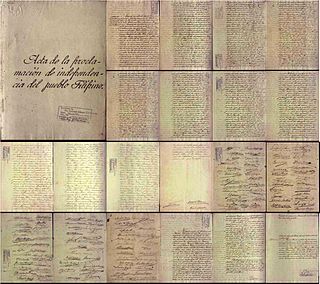
The Philippine Declaration of Independence was proclaimed by Filipino revolutionary forces general Emilio Aguinaldo on June 12, 1898, in Cavite el Viejo, Philippines. It asserted the sovereignty and independence of the Philippine islands from the 300 years of colonial rule from Spain.
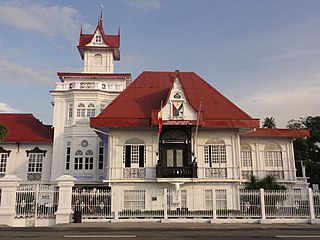
Independence Day is a national holiday in the Philippines observed annually on June 12, commemorating the declaration of Philippine independence from Spain in 1898.

Artemio Ricarte y García was a Filipino general during the Philippine Revolution and the Philippine–American War. He is regarded as the Father of the Philippine Army, and the first Chief of Staff of the Armed Forces of the Philippines though the present Philippine Army descended from the American-allied forces that defeated the Philippine Revolutionary Army led by General Ricarte. Ricarte is notable for never having taken an oath of allegiance to the United States government that occupied the Philippines from 1898 to 1946.

The Hong Kong Junta was an organization formed as a revolutionary government in exile by Filipino revolutionaries after the signing of the Pact of Biak-na-Bato on December 15, 1897. It was headed by Emilio Aguinaldo and included high-level figures in the Philippine revolution against Spanish rule who accompanied Aguinaldo into exile in the Crown Colony of Hong Kong from the Philippines.
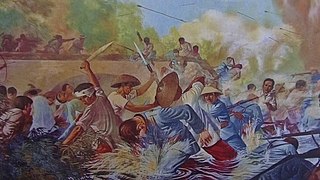
The Battle of Zapote Bridge was fought on February 17, 1897, as part of the Philippine Revolution. Filipino revolutionary forces led by General Emilio Aguinaldo defeated Spanish forces under the command of Governor-General Camilo de Polavieja. In this battle, General Edilberto Evangelista was killed.

The Battle of Binakayan–Dalahican was a simultaneous battle during the Philippine Revolution that was fought on November 9–11, 1896 that led to a decisive Filipino victory. The twin battle took place at the shores of Binakayan, in the town of Cavite Viejo ; Dalahican and Dagatan in Noveleta; and, to minimal extent, in Imus and Bacoor towns in Cavite, Philippines that lasted for two days before the Spanish army retreated demoralized and in disarray. The result of the battle was the first significant Filipino victory in the country's history.

The Battle of Imus, or the siege of Imus, was the first major battle of the Philippine revolution against the Spanish colonial government in the province of Cavite. It was fought between September 1–3, 1896 at Imus, Cavite province in the Philippines, right after Bonifacio's attack on the gunpowder magazine at the Battle of San Juan del Monte in Manila.

The Retreat to Montalban occurred during the Philippine Revolution after the 1897 Battle of Naic southwest of Cavite when Philippine General Emilio Aguinaldo's and his forces retreated to Puray, Montalban on June 14. The Spanish pursued the Katipunero forces retreating towards central Luzon, killing many of the revolutionaries. However, the retreat finally ended when Aguinaldo and the Filipinos won the Battle of Mount Puray, from which he would make his temporary headquarters, relocating it again to Norzagaray and Angat, until finally reaching the caves of Biak-na-Bato on June 24, 1897, and making it the new revolutionary headquarters.
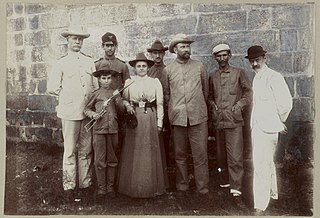
The Battle of Calamba was a battle fought between Filipino Revolutionaries in Laguna in the Philippines and the colonial forces of the Spanish Empire.
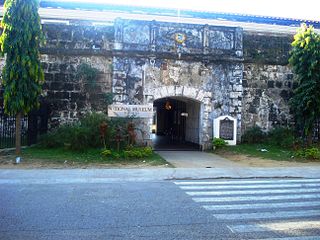
The siege of Fort Pilar was fought between April and May 1898 on then-town of Zamboanga in Mindanao as a part of the Philippine Revolution. One of the only few actions against Spanish colonials forces in Mindanao, the victory brought about by the Zamboangueño Ethnolinguistic Nation, after their capture of Fort Pilar several weeks later, paved way for the foundation of the short-lived Republic of Zamboanga.
The Battle of Tayabas was a 2-month campaign of the Philippine Revolution that saw intense guerrilla warfare and bloodshed for the province. The battle occurred shortly after Aguinaldo's return from Hong Kong in May of the same year. Tayabas was just one of the many triumphs for the revolutionaries in that year, leading up to Philippine independence.
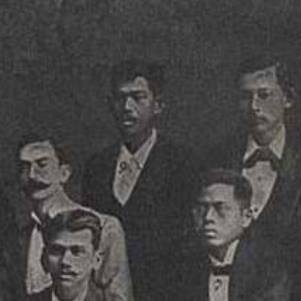
Salvador Estrella was a Filipino general who fought in the Philippine Revolution and the Philippine–American War. For his courage in battle, he earned the moniker "red blooded."

The Dictatorial Government of the Philippines was an insurgent government in the Spanish East Indies inaugurated during the Spanish–American War by Emilio Aguinaldo in a public address on May 24, 1898, on his return to the Philippines from exile in Hong Kong, and formally established on June 18. The government was officially a dictatorship with Aguinaldo formally holding the title of "Dictator". The government was succeeded by a revolutionary government which was established by Aguinaldo on June 23.

Felipe Buencamino y Siojo was an infamous Filipino turncoat, lawyer, diplomat, and politician. He fought alongside the Spaniards in the Philippine Revolution but later switched sides and joined Emilio Aguinaldo's revolutionary cabinet. He was a member of the Malolos Congress and co-authored the Malolos Constitution. He was also appointed as Secretary of Foreign Relations in the cabinet of Aguinaldo. After he left the revolutionary government, he co-founded the Federalista Party and became a founding member of the Philippine Independent Church.



















